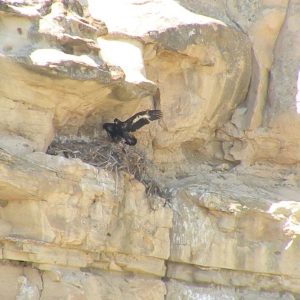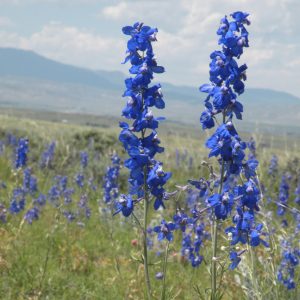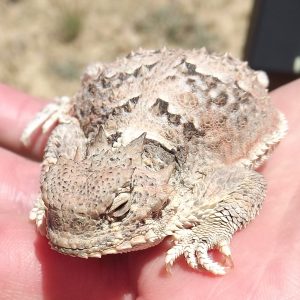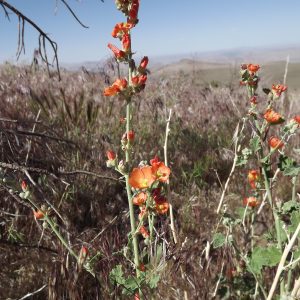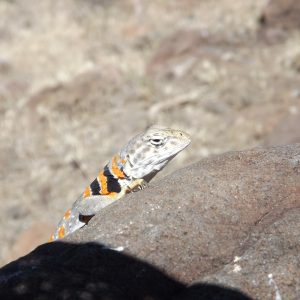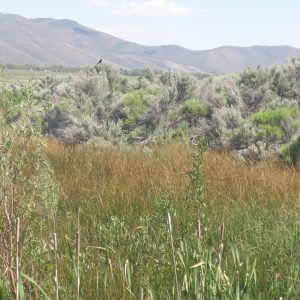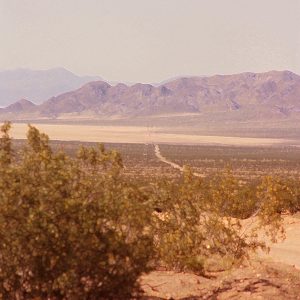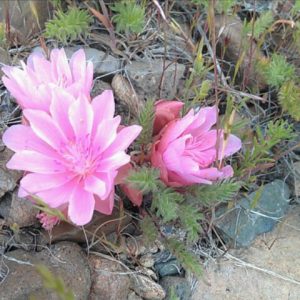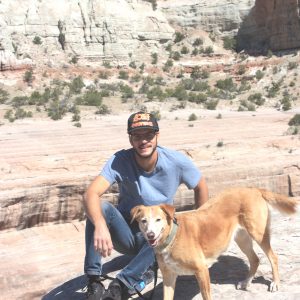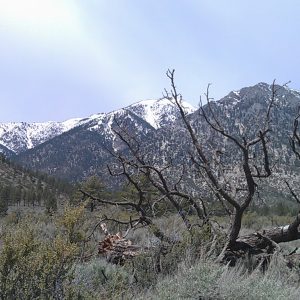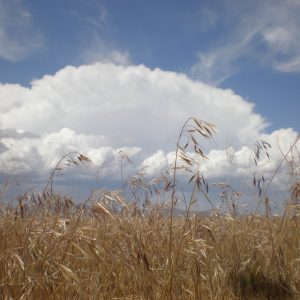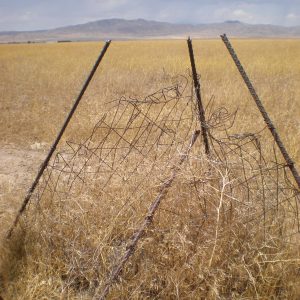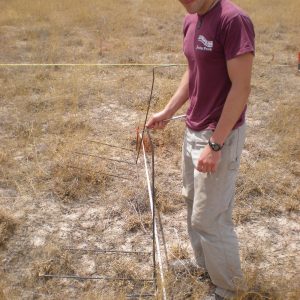My first three weeks here have been amazing. I get to travel to beautiful locations all around the county, work at the Safari Park, and live close to the beach. It really could get much better. Its surprising to me that that there are so many new plant species here, I wouldn’t have expected there to be so much variation just a few hours south of where I first took field botany. I never thought I would find the dry desert areas interesting, but the more I look the more there is to see. I am even more excited for the next five months than when I first started. There are multiple projects going on at the park and I hope I can find time to learn a little bit about all of them.
Central Valley
I’ve had the pleasure of spending my internship on the Cosumnes River Preserve in central California. This week, I learned how to properly install a barbed wire fence, which sounds much easier than it is in reality. It’s interesting, though. I hail from Kansas, and everybody automatically assumes that capable farm boy has come to town, but in actuality I come from small town Americano. I have worked on farms before, but just as a hand during hay season. I’m just a hayseed… not a rancher. Now, through the BLM, I have learned to operate many of the equipment used for land management, such as 90 hp tractors, chainsaws, UTV’s, et al. It is ironic that the perception people have of me is now mostly true, but they are unaware of the means by which I acquired these skills. I guess it goes to show that people have assumptions about the lifestyles of peoples’ from different states, especially the assumptions Californians make. I wouldn’t be surprised if the people of California thought that California was half the country, and this is not a preconception, but a conclusion made after meeting Californians. I consider myself well traveled, and there is definitely a self-centralism in this state. That is not to say that I don’t consider California “unworthy” or “irredeemable” in any way. On the contrary, I absolutely love the state of California and all it has to offer. I’m very grateful that CLM was able to extend my internship (and my mentor for making it possible), but I do feel that people here take a whole lot for granted. One thing that the CLM Internship program offers is a way for young people such as myself, who are interested in this sort of job field, to get away and see if indeed the grass is greener on the other side of the fence; to go places far from their realm of comfort and gain exposure that they would not otherwise have the opportunity. I hope the other interns involved in this program feel the same way and don’t take it for granted. Thank you, Chicago Botanic Garden, for creating opportunities, especially in the current economic atmosphere.
Cody, Wyoming – Part 2
It’s hard to even separate the last few weeks from the preceding ones– it’s all been a blur. I can’t believe I’ve already been here for 2 months. But the job is moving right along, mostly monitoring golden eagle nests and watching for plant populations to collect for the Seeds of Success program. The 2 eagle chicks I’ve been watching are almost ready to fledge (leave the nest), which I am excited to hopefully see. I am also hopeful that I will be involved in banding one of them once it leaves the nest and is on the ground for a few days. The seed collection project may have a minor setback, as a significant chunk of the scurfpea population I was planning to collect was washed out and covered with sediment in a heavy rainstorm. Mayhap there will be enough plants left for a collection, but perhaps it is time to go to Plan B and identify alternative collection sites.
Apart from work, I’ve had my first visitors from home this past weekend. My mom and sister came to visit, and I took them to work with me to monitor the eagle nests. We also went to Yellowstone for a day of ecotourism. Last week I watched the 4th of July parade through town and some fireworks. It’s lovely in the Cody Field Office right now; the blue delphinium is blooming and the occassional short but impressive thunderstorm rolls through from time to time, which keeps cooling things off so the summer heat hasn’t been terrible. All in all, it’s still the best job I’ve ever had and I feel very fortunate to be in this place among these people and enjoying working outdoors.
- Golden eagle chick stretching its wings
- Delphinium (larkspur)
Heat of the Summer
There are lonely hours. How can I deny it? There are times when solitaire becomes solitary, an entirely different game, a prison term, and the inside of the skull as confining and unbearable as the interior of the housetrailer on a hot day. p95 Desert Solitaire
July. Though all the windows are wide open and the blinds rattle in the breeze the heat is terrific. The inside of the trailer is like the inside of a kiln, a fierce dry heat that warps the loose linoleum on the floor, turns an exposed slice of bread into something like toast within half an hour, makes my papers crackle like parchment. p128-9 Desert Solitaire
Edward Abby describes what I am feeling right now very well- loneliness. I miss trees and mountain trails, cold weather and the ability to go outside and not want to die of heat (highest temperature so far this summer: 120 F). The desert is a remote and terrifically hot place at times.
Yes July. The mountains are almost bear of snow except for the patches within the couloirs on the northern slopes. Consoling nevertheless, those shrunken snowfields, despite the fact that they’re twenty miles away by line of sight and six to seven thousand feed higher than where I sit. They comfort me with the promise that if the heat down here becomes less endurable I can escape for at least two days each week to the refuge of the mountains- those islands in the sky surrounded by a sea of desert. The knowledge that refuge is available, when and if needed, makes the silent inferno of the desert more easily bearable. Mountains complement desert as desert complements city, as wilderness complements and completes civilization.” p129 Desert Solitaire
Though I am having a tough time being in Needles CA for my internship at this moment, I realize it is really helping me to do some self reflecting. I have time to spend with myself, and only myself, in order to reflect on what I want to do with my life and how I want to live it- though I feel this way now, I am sure it will only help me grow in the long run.
Laney
Internship program on your marks, get set… and GO!!
Life has been hectic starting this internship with CLM, but good. I am stationed in Denver, Colorado at the state office with Carol Dawson, a wonderful person who is able to get way more done than is humanly possible, and Peter Gordon, a great guy from Australia who is very helpful, fun to chat with, and was an intern through this program himself before joining Carol. Right away, we were off and running with important things to do, from being briefed about what we are doing, setting up at the office, and prepping for our first adventures.
Our first two weeks we focused on monitoring rare plants, Penstemon harringtonii and Sclarocactus glaucus, but will not go into detail about it, as you can read about it from my co-intern, Sama, who posted about it last week. The third week was busy with training in Chicago, where we met all the other interns stationed across the western states, met many of the people behind the scenes of this program, and taught many skills and information needed for most of the internships. This current week, we have performed our other half of our duties, Seeds of Success (SOS).
Our current objective for SOS is to scout out new or old potential locations for common plants that are great for restoration and to collect plant genetic diversity for the security of our future. During our scouting endeavors, Peter takes to time to teach us how to identify plant families (such as the rose family, lily family, etc.), what the common plants are, and using a dichotomous key to figure out the plant species when we are working without him or Carol (such as keying out a prickly pear cactus species of Opuntia polyacantha). He also informs us on what to look for in the size of a population for seed collection, the difficulties of certain species
if the fruits pop open when touched, scattering the tiny black/brown seeds over 30 feet), and many other necessary procedures we must follow in order to make our collection more accurate and viable for storage (correct labeling, information needed recorded, etc.).
We have yet to collect seeds because it requires a lot of prep work now in order to find what has a large enough population to harvest, save time later and to prevent missed opportunities, and many of the plants are not in fruit yet. But, while investigating potential collections, a phenomenal bonus are all the spectacular landscapes, land formations, and flowers that we get to witness and admire. As Peter has mentioned as hikers and runners pass by us, that they took a day off from work just to be here while we are paid to work and enjoy the marvels of our Earth.
a New Englander’s introduction to Nevada
Hello from Carson City, NV!
My name is Aileen Shaw and I am working with two other interns, Andie and Sasha, and the Carson City BLM on a Sage Grouse project.
“The greater sage-grouse is a large, rounded-winged, ground-dwelling bird, up to 30 inches long and two feet tall, weighing from two to seven pounds. It has a long, pointed tail with legs feathered to the base of the toes. Females are a mottled brown, black, and white. Males are larger and have a large white ruff around their neck and bright yellow air sacks on their breasts, which they inflate during their mating display. The birds are found at elevations ranging from 4,000 to over 9,000 feet and are highly dependent on sagebrush for cover and food.
Currently, greater sage-grouse are found in Washington, Oregon, Idaho, Montana, North Dakota, eastern California, Nevada, Utah, western Colorado, South Dakota and Wyoming and the Canadian provinces of Alberta and Saskatchewan and occupy approximately 56 percent of their historical range.
After a thorough analysis of the best available scientific information, the Fish and Wildlife Service has concluded that the greater sage-grouse warrants protection under the Endangered Species Act. However, the Service has determined that proposing the species for protection is precluded by the need to take action on other species facing more immediate and severe extinction threats.
As a result, the greater sage-grouse will be placed on the list of species that are candidates for Endangered Species Act Protection. The Service will review the status of the species annually, as it does with all candidate species, and will propose the species for protection when funding and workload priorities for other listing actions allow.
Evidence suggests that habitat fragmentation and destruction across much of the species’ range has contributed to significant population declines over the past century. If current trends persist, many local populations may disappear in the next several decades, with the remaining fragmented population vulnerable to extinction.” (www.fws.gov/mountain-prairie/species/birds/sagegrouse)
As part of building the scientific facts for this continued observation of the Sage Grouse a grant has made it possible for my fellow interns and myself to participate in inventorying the plant species found in the Sage Grouse habitat. Andie, Sasha and I have been working in Nevada for the last month, two weeks of which were spent camping in Mill Canyon in the Pine Nut Mountains about two plus hours south east of Carson City. It was an incredible experience. For a native of from New Hampshire the desert is a many layered place- the first is just brown, brown, brown- but along with that are many layers of thousands of shades of greens with miniscule flowers just waiting for someone to see them. Some of the larger flowers that are my favorites are the desert mallows (Sphaeralcea sp.) and the Paintbrushes (Castilleja sp.).
So far we have been lucky (in my opinion) to not have seen any snakes. There are, however, an incredible abundance of lizards. I am not sure of their species, possibly the Black-collard lizard (Crotaphytus insularis), Horned lizards ( Phrynosoma sp.) and Collard Lizard ( Crotaphytus collaris). We have also seen antelope, Jack rabbits, Desert Cotton tails, Sage Grouse, Mustangs, Chukars ( Alectoris chukar) a partridge that hatched out while we were out camping so we got to see all the chicks lined up following mom. Two night that we got back to camp around 9:00 ish at night we saw a pair of owls hunting.
So far the weather has been kind to us and we have had no damaged tents, wet nights or flat air-mattresses. While the days are long, hot and dry, they are filled with all kinds of adventures. Some rather frustrating, like hiking to a GPS point over 2 km away up and down about three “hills” with slopes at about 40-45 degrees to find at the base of the last hill… yup, you guessed- a road. But we did get to catch a horned lizard so that was fun.
As for the good parts…. Imaging being the only three people in hundreds or thousands of miles with a sky so blue there isn’t even the hint of a cloud, a horizon that stretches as far as you can see all around, mountains so big in the distance they fade to blue and purple with snow caps still striking against the sky. Imagine the silence- hardly a plane crosses over head, no cars go speeding by, no radios, no mechanical noises. Only the sounds of nature reach your ears. Only nature fills all your senses. One morning I woke up at 5 and crawled out of my tent and just sat there and listened. There was no sound but the silence was full of meaning, full of life, just holding its breath before the start of another day. A day that started with the music from a single bird’s throat.
So what are we doing besides making a lot of people jealous? We hike to a GPS location, usually a nesting site or a place the birds have been tracked to via telemetry, and set up a transect. Along this three pronged ( 25 meters each) plot we measure the canopy cover, plant heights, percent ground cover, plant species, Pinyon pine and Juniper encroachment ( a 100 meter square around the central plot) and general plant species list of the area. Sounds simple enough, but with GPS points, projecting etc, compass readings, distance estimates and angles and degrees you have to stay on your toes!
Camping with the USGS
In addition to my botany work at the Bureau of Land Management, this month I had the opportunity to participate in a study conducted by another federal agency, the USGS. The study aims to determine the effects of various vegetation treatments on sage grouse habitat, and to identify any benefits of different treatments for sage grouse. During my two weeks camping in the field, I acquired valuable experience conducting vegetation point transect surveys as well as subplot vegetation sampling to determine species composition, cover and abundance. My time with the USGS has been great for many reasons. Working with a knowledgeable and experienced field crew has increased my field skills, I learned more about the flora of the region, and I met great people!
A Different Perspective
I traveled over 3,000 miles to get to Carson City, Nevada. Once here, I found out the surrounding lands were very different from what I originally imagined it would be like.
This internship proved to provide me with multiple opportunities to expand and grow though my experiences. The Drive across the nation was one of the most amazing journeys I took. I drove out with my two best friends Doug and Lady, the dog I rescued in high school. All of us were on a limited budget, we had with no reservations and only vague ideas of national parks and general destinations we wanted to camp at and visit. I felt a little like Kerouac embarking on the ultimate adventure, a right of passage almost.
Since I began my internship I’ve met great people and have been able to participate in various projects. Our team of nine interns accomplished a great task of planting 21,000 Bitterbrush seedlings as a fire restoration project. Although the work was challenging we made each day entertaining and unique. While we were busy helping establish the bitterbrush seedlings into their new homes I was able to begin to become introduced to the plants of the west. I became familiar with the landscape and as time went on and we took on monitoring, and conservation projects I found myself adjusting to life out west.
I still have a lot to learn so off I am on another busy work week in Carson City, Nevada.
Desertification
July 8, 2011
Las Cruces, N.M.
The sun beats incessantly
To a soundless drum
Today is the end of my third week as a CBG intern. Stationed in southern New Mexico, I have been told that this is one the driest years on record for the area. The springs rains failed to show up, and the landscape is brown and crispy all around. This is reflected in the numerous record sized fires that continue to burn throughout the southwest. The skies here are often hazy with smoke, and gusts of powerful winds are not uncommon. We are all hoping for the monsoon season to get here soon, otherwise it is questionable how successful the seeds around here will be.
Yet despite the drought, life still persists in this harsh land. The large majority of the plants here I had never met before, and it is exciting to learn about a completely different flora. Ocotillo, mesquite, creosote, cholla, prickly pear, yucca, acacia, and sotol are just a few of these new plants. But one cannot forget the Agaves. I was fortunate enough to see a few of these in full bloom yesterday at the Little Hatchet Mountains. These striking plants spend 8-20 years in a strictly vegetative state, but when the stars align and the time is right they will send up a single stalk (can reach over 13 ft!) of flowers before dying. In honor of their patience I urge you to sip your next tequila slowly, pondering such a life strategy.
Like many other interns my main job here is to collect seeds. So far we have made a collection of, after much debate, Populus deltoides along the Tularosa river. Cottonwoods, I’ve found out, are quite confusing in this area and ideally one has a collection of multiple developmental stages of the tree in order to make a confident identification. No matter the species, though, they provide welcome shade for a day in the field. I look forward to making more seed collections, and to begin working with the other CBG intern next week.
East meets West
Coming from the East Coast, it’s interesting to think about the idea of “land management.” The concept seems broad, encompassing a whole range of activities under one blanket term. Are we protecting wildlife (or wild life, to use that simple but significant difference in the term)? Do we see the work as resource preservation or resource conservation? Or something else?
I just spent the last few days with the Cedar City BLM range crew, mainly to familiarize myself with the vegetation, though we barely scratched the surface. The surprising part was that I had never been exposed to “range” work before, especially as a field of study. The range crew told me that we were surveying the BLM grazing allotments for vegetation species and abundance. This was my first surprise. In the East, land seems to be categorized quite specifically for its use. But here we were, out on one small plot of the millions of acres of BLM land to see how the land is suited for grazing. Meanwhile, some of my other seasonal counterparts were out surveying the vegetation in other areas to see if it was adequate habitat for sage grouse.
On the first day, we visited a site that one of the range crew workers said “we should’ve surveyed by satellite;” it was parched and primarily filled with cheatgrass. Even the range cage, set up to protect a small plot of vegetation from grazing animals to see what grows in their absence was crumpled and full of taller cheatgrass. Biologists and rangeland managers alike would see it as problematic, and we joked about how a squatter could find a home there and never be bothered about it. Through my eyes, born and bred in the eastern U.S. and used to seeing an obvious purpose, plan, direction, or advantage in the state of the land, I was struggling to see this land’s place in the BLM’s grand scheme. With all the millions of acres, how do we look at this one site and see its potential for sustaining livestock with diverse vegetation for years to come?
Keep in mind, I understand the importance of this work. I see that this public land is in high demand for multiple uses and that our branch of the government spreads its resources thin over a diversity of projects with lofty goals. My simple point in these observations is that I am looking at a new landscape through alien eyes. I’m excited to spend these five months learning not only how land management works on the ground, but also how to look at the landscape and see all of its potential. I heard a long time ago that landscape conservation is all about seeing what could be and wrestling to make it happen. If I see an endless field of cheatgrass and a bludgeoned range cage, I want to see how it could become an ideal landscape. I want to see how our influence can take effect for the better.


